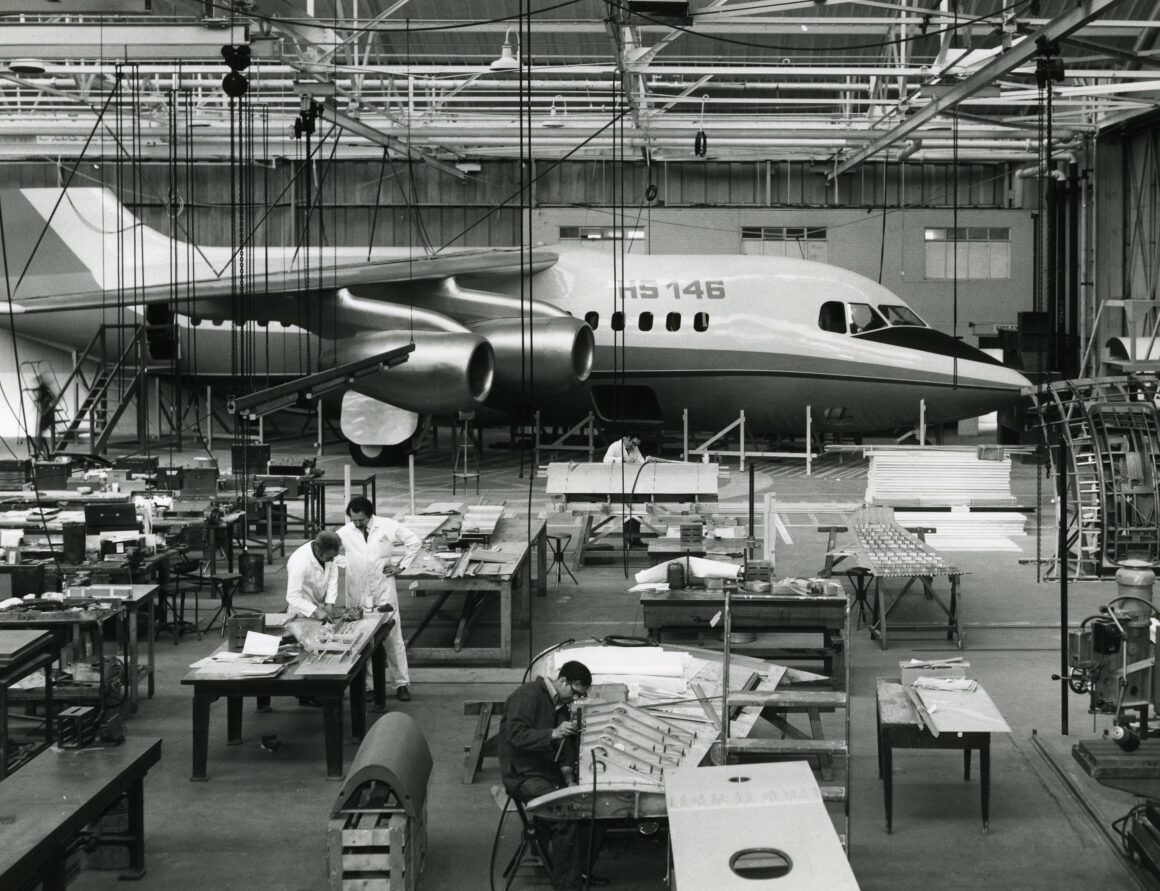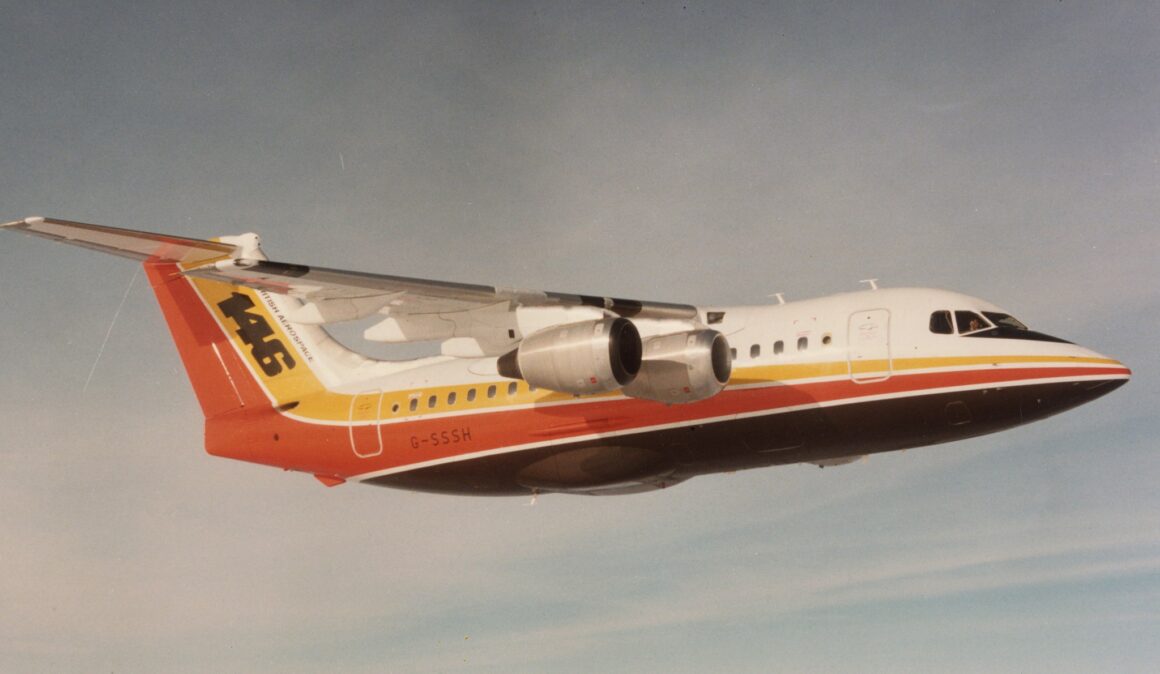The Fascinating Story of How the Last British Airliner Clawed Its Way to Success
Avgeekery contributor Brian Wiklem has released a riveting new book that tells the entire story about the BAe 146. The book tells the story behind the people who designed, built, and flew the original regional jet. It is available from LaJetee Press at https://www.lajeteepress.com.
These days, four-engine jetliners are a rarity at local airports. Sure, the Queen of the Skies, the Boeing 747, is still flying and relevant today, along with the Airbus A380 and even the Airbus A340. Those days are quickly coming to an end. But it’s no surprise flying two engines is less expensive than four, with engine and aerodynamic technology continuing to push the limits while requiring less fuel and less maintenance. So why on earth would an aircraft manufacturer begin designing and pitching a four-engine short-haul airliner? It’s complicated.

Developing a Viable Four-Engine Short-Haul Airliner
Hawker Siddeley, competing against not only Fokker, Boeing, and McDonnell Douglas but also homegrown manufacturer British Aircraft Corporation, was looking to develop the next generation of short-haul aircraft. For nearly twenty years, many different ideas and iterations of short-haul aircraft bounced around internally, ultimately settling on what would become the HS146, now known as the British Aerospace (BAe) 146 series of aircraft. Hawker Siddeley was working on an aircraft that would appeal to state-owned carriers operating in less than ideal conditions, such as unpaved fields and more rural areas. But rather than a prop aircraft, it was working on a short-haul jetliner.

The Advantages of Four Burning
This aircraft could operate entirely independently of ground service vehicles. Baggage compartments were waist high for ground crew, and the aircraft could be equipped with airstairs, eliminating the need for additional vehicles and complexity, and operating from remote fields fully contained. And, with four jet engines, a loss of an engine wouldn’t mean an immediate return trip to the airport, nor the concern that a two-engine aircraft (with a loss of engine) would have only 50% power remaining. With four engines, a loss would be mitigated to only 25%.
There was only one problem: these state-owned carriers often didn’t have the financial ability to support buying not only a jet aircraft but a brand-new one. A second problem would burst onto the scene and shut down any airline’s ability to consider a four-engine jet: The oil crisis of 1973.
Oil Crisis Creates a Need For More Efficient Jets
By 1974, the crisis was in full swing because of the support Israel was getting from the United States due to the Yom Kippur War. A barrel of oil tripled in cost by the end of the year, and there was no sign of it slowing down. This was the worst possible time to launch a four-engine jetliner.
Between homegrown political battles to keep the project alive and the manufacturers’ insistence that it be terminated, ultimately, Hawker Siddeley won, and the HS146 was terminated. But in the long run, this came back and bit Britain’s aviation industry hard, with the government fed up with bailing out various aerospace manufacturers, including Rolls-Royce with the RB211 and the Concorde debacle.
Turmoil in the British Aviation Industry

By 1977, the British government nationalized the aerospace industry under the 1977 Aircraft and Shipbuilding Industries Act in an attempt to save Britain from losing these industries. Enter the newly formed British Aerospace, where the government would fund and ultimately divest itself of its shares, concluding by 1985 its complete divestiture of British Aerospace, which would become a publicly owned and traded entity.
1977 saw the new board of directors argue about restarting the HS146 or continuing with the BAC Two-Eleven. Political considerations at play ensured the HS146 would continue on, and the BAC Two-Eleven would never make it off the drawing board. With the company moving forward with full-scale development and manufacturing, the world would change again, starting in the United States. Enter deregulation, where airlines were now free to fly and charge whatever they wanted.
The Industry Transforms Itself
Over the next ten years, the aviation industry worldwide would begin to shift away from state-owned carriers and move towards a free market, with airlines having to live and die by their own choices, pricing, and quality of service. The very market the HS146 was predicated on was disappearing quickly. Once the BAe 146 took its first flight, it began a tour to the two primary markets originally envisioned and viewed as its golden goose: The Far East (Japan, India, Thailand, Australia, Indonesia, and more), as well as a tour in Africa to numerous countries. These were the countries that BAe and originally Hawker Siddeley saw as customers, with state-owned carriers, rural operating conditions, and the need for a self-contained aircraft that desired jet service.
It was not to be. Not a single order came from the Far East (and it would be nearly eight years before an Australian and a Thailand-based carrier ordered the 146), and only one order came from Africa for a single aircraft. This was far from a sales success.
